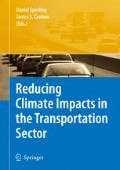Access this chapter
Tax calculation will be finalised at checkout
Purchases are for personal use only
References
American Farmland Trust, Alternatives for Future Urban Growth in California’s Central Valley: The Bottom Line for Agriculture and Taxpayers, Washington, DC: Author, October 1995.
American Public Transportation Association (APTA), “Table 4: 20 Largest Transit Agencies Ranked by Unlinked Passenger Trips, Fiscal Year 2005,” 2007 Public Transportation Fact Book, Washington, DC: Author, 2007, p. 10.
Associated Press, “Hybrid Sales Up 49 Percent,” September 17th, 2007. Retrieved December 27th, 2007, from http://news.moneycentral.msn.com/ticker/article.aspx?symbol=US:TM&feed=AP&date=20070917&id=7484280
Center for Transit Oriented Development and Center for Neighborhood Technology, The Affordability Index: A New Tool for Measuring the Affordability of a Housing Choice, Washington, DC: Brookings Institution, 2007.
Cortright, Joe, “Portland’s Green Dividend,” Chicago: CEOs for Cities, 2007.
Dill, Jennifer, “The Merrick: Travel Behavior and Neighborhood Choice,” Portland, OR: Metro, 2005.
Ewing, Reid, Bartholomew, Keith, Winkelman, Steve, Walters, Jerry, and Chen, Don, Growing Cooler: The Evidence on Urban Development and Climate Change, Washington, DC: Urban Land Institute, 2007.
Fulton, William, Pendall, Rolf, Nguyen, Mai, and Harrison, Alicia, Who Sprawls Most? How Growth Patterns Differ Across the U.S., Washington, DC: Brookings Institution, 2001.
Greene, David L., and Schafer, Andreas, Reducing Greenhouse Gas Emissions from U.S. Transportation, Washington, DC: Pew Center on Global Climate Change, May 2003.
Lloyd Transportation Management Association (TMA), 2006 Annual Report, 2006.
Metro, “The Portland Region: How Are We Doing?” Portland, OR: Author, March 2003.
Metro, “Metro Travel Behavior Survey Results,” 1994.
Money in Politics Research Action Project (MIPRAP), “Donors Who Gave More than Half the Money to Measure 37 Campaigns File over $600 Million in Claims; Could Earn Windfall on Investment,” April 19th, 2007. Retrieved December 27th, 2007, from http://www.oregonfollowthemoney.org/Press/2007/041807%20Release.htm.
Mortenson, Eric, and Hogan, Dave, “Land-use Fight is Oregonians’ Fight,” The Oregonian, October 1st, 2007.
National Association of Realtors, “Metropolitan Area Housing Prices, Single-Family 3rd Quarter 2007,” 2007. Retreived December 27th, 2007, from http://www.realtor.org/Research.nsf/Pages/MetroPrice.
National Transit Database, National Transit Profiles, 2005. Retreived December 27th, 2007, from http://www.realtor.org/Research.nsf/Pages/MetroPrice.
Nelson, Arthur C., Pendall, Rolf, Dawkins, Casey J., and Knaap, Gerrit J., The Link Between Growth Management and Housing Affordability, Washington DC: Brookings Institution Center on Urban and Metropolitan Policy, February 2002.
Nelson, Arthur C., and Sanchez, Thomas W., “Lassoing Urban Sprawl,” Metroscape, Winter 2003, pp. 13–19.
Portland Office of Sustainable Development, 2005 Progress Report on the City of Portland and Multnomah County Local Action Plan of Global Warming, Portland, OR: Author, 2005.
Portland Office of Transportation, “Table X: Bicycle Commute Mode Share, 1999–2006,” 2007.
Replogle, Michael, “Improving Mobility While Meeting the Climate Change Challenge,” Presentation at Metro, November 19th, 2007.
Sightline Institute, Cascadia Scorecard 2007: Seven Key Trends Shaping the Northwest, Seattle, WA: Author, 2007.
State of Oregon, Measure 37, 2004. Retrieved December 27th, 2007 from http://www.sos.state.or.us/elections/nov22004/guide/meas/m37_text.html.
TriMet, TriMet System Map, Portland, OR: Author, 2007.
U.S. Census Bureau, “Average Annual Expenditures of all Consumer Units by Size and Region, 1995 to 2004,” 2005. (2005a) Retrieved November 14th, 2007, from http://www.census.gov/compendia/statab/tables/07s0668.xls.
U.S. Census Bureau, 2005 American Community Survey, 2005. (2005b) Retrieved December 27th, 2007, from http://www.census.gov/acs/www/.
U.S. Census Bureau, Metropolitan Statistical Areas Population Estimates, July 1st, 2006. Retrieved December 27th, 2007 from http://www.census.gov/popest/metro.html.
U.S. Department of Labor Bureau of Statistics, “Selected Western Metropolitan Service Areas: Average Annual Expenditures and Characteristics,” Consumer Expenditure Survey, 2004–05, 2005. Retrieved December 27th, 2007, from http://www.bls.gov/cex/2005/msas/west.pdf.
U.S. Department of Transportation (DOT), Bureau of Transportation Statistics, “Table 1–33: Vehicle-Miles Traveled (VMT) and VMT per Lane-Mile by Functional Class,” 2006. Retrieved December 27th, 2007, from http://www.bts.gov/publications/national_transportation_statistics/html/table_01_33.html
U.S. Energy Information Administration (EIA), “Table 50: Light Duty Vehicle Miles Traveled by Technology Type,” 2007 International Energy Outlook, Washington, DC: U.S. Government Printing Office, 2007.
U.S. Environmental Protection Agency (EPA), Inventory of U.S. Greenhouse Gas Emissions and Sinks: 1990–2005, executive summary, Washington, DC: U.S. Government Printing Office, 2007, p. ES-7.
Author information
Authors and Affiliations
Editor information
Editors and Affiliations
Rights and permissions
Copyright information
© 2008 Springer Science+Business Media B.V.
About this chapter
Cite this chapter
Rose, E., Burkholder, R. (2008). CO2 Reduction Through Better Urban Design: Portland’s Story. In: Cannon, J., Sperling, D. (eds) Reducing Climate Impacts in the Transportation Sector. Springer, Dordrecht. https://doi.org/10.1007/978-1-4020-6979-6_8
Download citation
DOI: https://doi.org/10.1007/978-1-4020-6979-6_8
Published:
Publisher Name: Springer, Dordrecht
Print ISBN: 978-1-4020-6978-9
Online ISBN: 978-1-4020-6979-6
eBook Packages: Earth and Environmental ScienceEarth and Environmental Science (R0)

